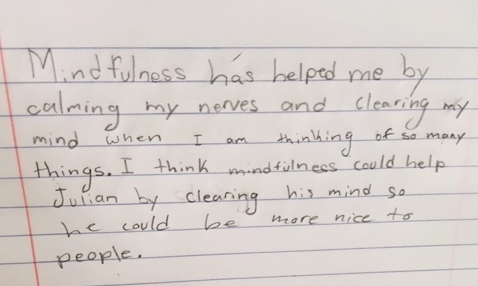I’ve mentioned before in previous posts that I started practicing mindfulness, or mindful meditation, back in March when I stumbled upon Dr. Lindsay Bira‘s meet-up group. (See the video below about mindfulness if you have no idea what I’m talking about.) Mindfulness, again, isn’t some weird, fluffy hippie stuff; it is research-based science that proves that you can train your brain to have better focus, attention and emotional regulation. After attending a couple drop-in mindfulness classes guided by Dr. Bira, I began to notice physical and mental benefits: my stress/anxiety level had decreased drastically, I felt like I could think more clearly (no more mommy brain!), and, overall I was calmer and happier. Knowing I would be returning to work as an inner-city charter school educator in the not so distant future, I began thinking about how practicing brief mindfulness techniques in the classroom could benefit the staff, but especially my (K-4) students who seemed to lack the basic ability to focus, emotional and behavioral regulation, and self-control. Coincidentally, Dr. Bira had recently trained an elementary school staff in mindfulness practices, and was happy to train ours.
In the training, we learned about the science of mindfulness, and were provided the practical tools to implement mindful practices with our students. In the first three months of school, I began every class with 4-5 minutes of mindfulness, usually guided by a script designed specifically for kids. (I taught all 650 kindergarten through 4th grade students on a weekly basis for 45 minutes, and practiced this technique with each class, altering the activity for the specific grade-level.) After just a couple weeks, I noticed the kids were more engaged in whole-group lessons for longer, they were nicer to one another, classroom management became easier, and the overall classroom environment was just a lot more calm and peaceful than in my previous years of teaching. The students came to expect to begin each class with this time to “calm down their bodies and minds in order to prepare their brains for learning”, and really seemed to enjoy this rare time in their fast-paced, chaotic days.

A few months into the school year, I met Dr. Bira for coffee, and told her, “I know this may sound crazy, but I really think mindfulness is the secret to learning and education, and here’s two reasons why: If you can teach children metacognition, which is the ability to think about thinking, that is HUGE!” Metacognition, or higher-order thinking enables understanding, analysis, and control of one’s cognitive process, and is said to be the foundation for learning. If, through mindfulness practices, we can teach children the skill of thinking about thinking, to notice when their minds have wondered from what is being taught and to bring it back, we are laying a solid foundation for learning. “Second,” I continued in my rant to Dr. Bira, “mindfulness helps us create a buffer between something that happens to us (a stimulus), and how we react to it, and that is the core of emotional and behavioral regulation.” If we can teach students to create that buffer between something that happens to them, and how they choose to react to it, we are teaching them to have complete emotional and behavioral control, or, self-control, which is the number one predictor of success, according to Walter Mischel’s life-long research on self-control (The Marshmallow Test).
I recently came across AnneMarie Rossi, whose research supports the benefits of teaching mindfulness to children in schools. In her TEDx talk she describes mindfulness as the foundation for all other learning, and here’s her reason why: research shows that self-control is the most important predictor of success in human beings, over race, language, socio-economic status, standardized test scores, or even IQ, and mindfulness exercises are designed to train your brain to have focus, attention and emotional regulation, otherwise known as self-control. In addition, her research, and many other studies, have shown that mindfulness decreases depression, anxiety and stress while also increasing focus, academic achievement and overall feelings of well-being, happiness. So, she continues, if we know this fact, then why aren’t we teaching it?
Part of the reason mindfulness is not taught in schools, according to Rossi, is that for a long time, these “skills for success” were seen as a privilege, only taught in well-funded schools or through expensive individual instruction to CEO’s, celebrities, top athletes, and other great leaders. But, she goes on to argue, children living in generational poverty need these skills more than anyone because we know that poverty is traumatic, and trauma changes the brain, so without practices like mindfulness gifted children are being left behind. I think Rossi would be as thrilled as I was to learn that just this year the U.S. Education Department awarded $3 million to a team of researchers to study mindfulness with approximately 2,000 kindergarten through second-grade students in 30 high-poverty Chicago public school over the course of four years. I have no doubt this study will add to the thousands of other research studies that prove the benefits of practicing mindfulness, and hope that young children in high-poverty schools become a target for mindfulness practices.
Having witnessed the benefits of practicing mindfulness in the classroom, I am right there with Rossi when she says that mindfulness should be offered in every school, in every county, in every district, in every state, but especially with children growing up in poverty. Since she, nor I, have the ability to immediately make that happen, I will instead spend the next few weeks sharing the research, resources, experience and benefits of practicing mindfulness with kids in hopes that the more parents and educators are aware of this knowledge, the more children will ultimately benefit.
